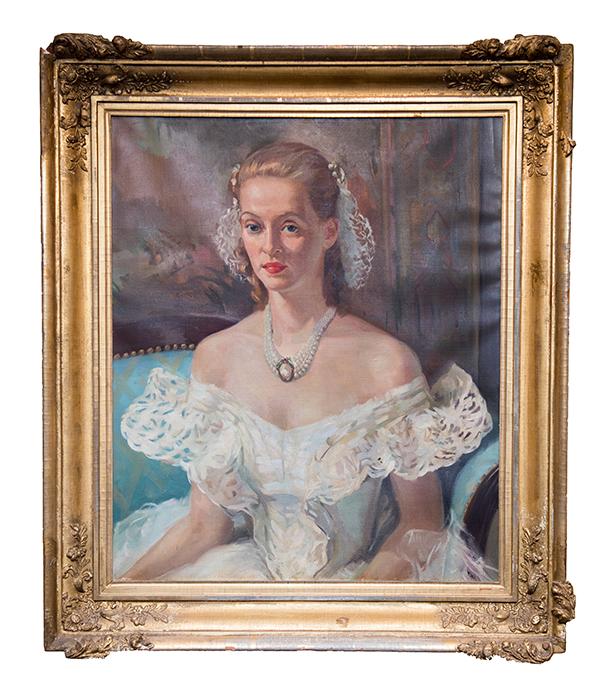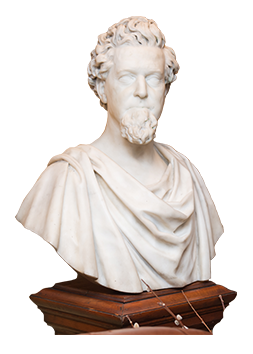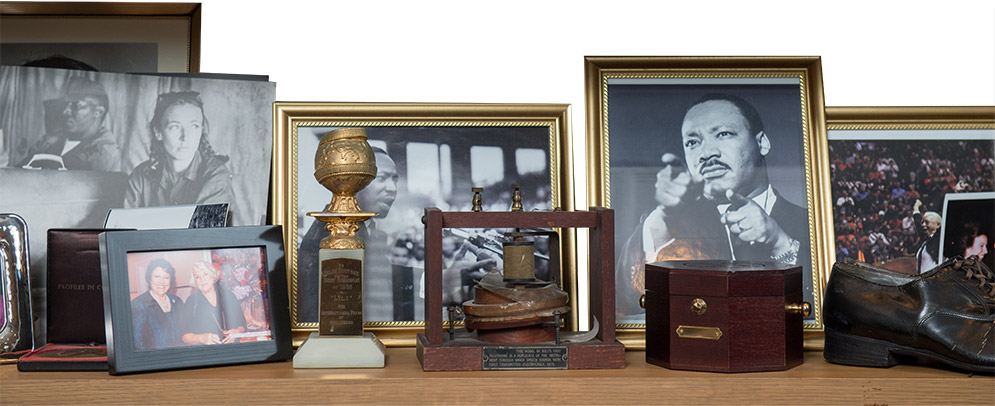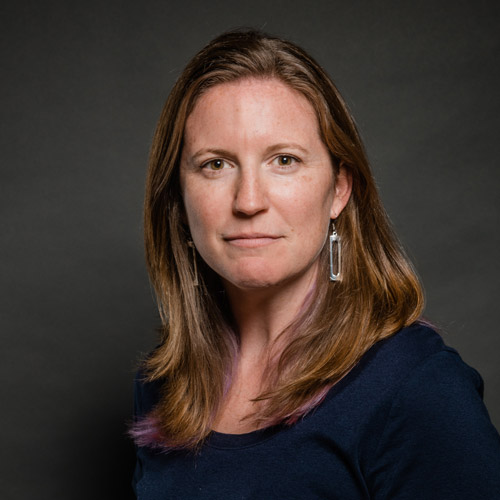Keeper of the Treasures
Howard Gotlieb Archival Research Center director Vita Paladino: great narratives, all with meaning
Vita Paladino works in an office unlike any other. She shares space with Lauren Bacall’s Oscar and a pair of scuffed shoes worn by Fred Astaire. Behind her desk is an oil painting of Bette Davis in a gilded frame—a gift from Davis’ son. And that’s just for starters.
As director of the Howard Gotlieb Archival Research Center (HGARC), Paladino (MET’79, SSW’93) is the chief curator of the center’s vast repository, 11 miles of shelves containing millions of items from a long list of 20th- and 21st-century movers and shakers.

Housed in the University’s Mugar Memorial Library, the center has letters written by actor Robin Williams, the personal and professional papers of journalist Dan Rather (Hon.’83), and scrapbooks, artwork, and manuscripts from actor Michael Douglas. There’s also Richard Nixon’s resignation letter, 83,000 items and correspondence that belonged to the Rev. Dr. Martin Luther King, Jr. (GRS’55, Hon.’59), and a death mask that was molded from the face of Napoleon Bonaparte. It’s not surprising that some of the material has been donated by BU alums, like Geena Davis (CFA’79, Hon.’99) and MLK, but most of its 2,000 donors have no affiliation with BU.
BU Today’s new series, “Capturing History,” looks at the Gotlieb Center’s acquisitions and its mission as it moves forward in the digital era and continues to expand its holdings.
Such collections don’t simply land on its doorstep. Paladino seeks them, looking for people whose accomplishments align with BU’s student and faculty interests and curriculum.

On a shelf in Paladino’s office: a bust of writer W. Somerset Maugham (far left); a white box containing prima ballerina Anna Pavlova’s ashes (center); Lauren Bacall’s Oscar (second from right); a statuette of Katharine Hepburn from film producer Joseph E. Levine’s collection (far right).
Born and raised in New York, Paladino studied at the feet of Howard B. Gotlieb (Hon.’88), who founded the center in 1963 as Special Collections (it was renamed the Howard Gotlieb Archival Research Center on its 40th anniversary in October 2003). Gotlieb’s novel approach was later emulated by other research institutions: soliciting donations from up-and-comers as well as from the famous and legendary while they were still alive instead of waiting until their death and buying materials at auction. He would personally help them cull the most meaningful material from their lives.
Gotlieb charmed, pleaded, and wheedled in his quest to collect contemporary material, according to his New York Times obituary, with great success, gathering papers and artifacts from more than 2,000 standouts in their field, from Bette Davis to journalist David Halberstam.

In 2006, Paladino succeeded Gotlieb as HGARC director, a career shift for a woman with a master’s degree in social work who had had other plans.
“I was planning to do a clinical career, which is listening to people’s narratives and secrets,” she says. “Now I listen and preserve them.”
She has heard many stories over the years, whether over a lunch with journalist Oriana Fallaci or during a visit with Lauren Bacall, whom she took backstage to meet actress Angela Lansbury while she was performing on Broadway. All three women donated their papers, scripts, and other items to the HGARC collection.
When Lauren Bacall was considering whether to give her love letters from Humphrey Bogart to the Gotlieb or to its major rival in the field, Paladino recalls, the deal broke her way when the other curator made a fatal faux pas. He asked for Bogart’s correspondence instead of Bacall’s. Paladino says that shortly after that she began receiving material from Bacall. And when Bacall died, the love letters and her career Oscar were delivered to her desk.
“Definitely a case where I felt being a woman really helped,” Paladino says.

On this shelf: photos of Paladino with actor Leonard Nimoy (Hon.’12), poet Nikki Giovanni, and actor Forest Whitaker.
She counts Bette Davis’ son, Brookline resident Michael Merrill (LAW’76), as a close friend, and she dined regularly with Alistair Cooke when he was in Boston filming for Masterpiece Theatre. Fallaci was like a sister, Paladino says, and she spoke at her memorial service, alongside Isabella Rossellini and Christiane Amanpour.
Paladino is fond of quoting her predecessor: “You have your shrink and you have your curator.”
“I’m not in awe of these people,” she says. “I have curiosity about them. I realize they have kids, a mother, a father. I give them a lot of deference and let them know I’m not just out to get their goodies.”

Much of Paladino’s success is on display in her office. Among her favorite trophies is a framed decree from the New York City Council exonerating Ethel Rosenberg more than 50 years after she and her husband, Julius, were executed after being convicted of espionage. Paladino acquired the Rosenbergs’ letters to each other from their sons in 2013.
“It was an anti-Semitic episode,” she says. “It’s a black mark on us, and I don’t want it to be forgotten.”
Also in her office are a marble bust of Isaac Rich, one of BU’s founders, and the Golden Globe award for best screenplay given to Helen Deutsch for the 1953 film Lili.
Above Paladino’s desk is the oil painting of Davis that was used in the film Jezebel. It was given to Davis by Warner Bros. executive Jack Warner before their relationship was poisoned by contract disputes that went on for years. Michael Merrill in turn gave it to the HGARC.
Her bookshelf holds an urn with the ashes of virtuoso keyboardist Rosalyn Tureck, considered the “high priestess of Bach,” as well as a vessel with the cremated remains of Ballet Russes prima ballerina Anna Pavlova, which was part of the personal collection of English ballerina Alicia Markova.
The HGARC archive offers stories and insights, Paladino says, such as how Markova, a frail, knock-kneed child, became not just a ballerina, but a muse for choreographer George Balanchine and artist Henri Matisse.
“We have these great narratives—people should have the opportunity to hear them and be inspired by them,” she says. “They all have meaning.”
Meg Woolhouse can be reached at megwj@bu.edu.
Read other stories in our “Capturing History” series here.

This Series
Also in
Capturing History
-
March 2, 2018
Oscars Up Close
-
April 5, 2018
MLK on Display at BU’s Gotlieb Center
-
October 11, 2018
Gotlieb Archival Research Center Celebrates the Bay State Banner



Comments & Discussion
Boston University moderates comments to facilitate an informed, substantive, civil conversation. Abusive, profane, self-promotional, misleading, incoherent or off-topic comments will be rejected. Moderators are staffed during regular business hours (EST) and can only accept comments written in English. Statistics or facts must include a citation or a link to the citation.